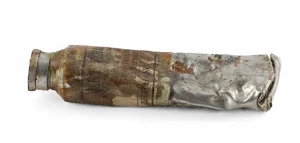Many of the great milestones in art history involve famous artworks. For example, at the time of its creation, Donatello’s statue of David was the first male nude sculpture created since antiquity and is now one of the great works of the Early Renaissance. When Emperor Napoleon had Anne-Louis Girodet’s 1802 painting Ossian Receiving the Ghosts of French Heroes hung at his chateau, it is considered by some as one of the first times Romantic painting entered the mainstream. And Picasso’s landscapes from 1909, among them Reservoir at Horta de Ebro, are often considered the start of Cubism. But there are few recorded moments when the arts were changed forever because of innovation in the artistic media itself.
On September 11, 1841, an American painter named John Rand submitted his patent for the collapsible paint tube. By the mid-nineteenth century, most painters did not mix their own paints, instead getting their colors from vendors. However, the containers used before Rand’s invention were rather primitive. The most portable way to store paint was a pig’s bladder tied with string. You would choose a few colors, then pierce each bladder with a pin or a tack to get the paint out. With no way to plug the hole, you had to use all the paint right then and there. Furthermore, these pig’s bladders were often difficult to transport, limiting painters’ ability to work with as diverse a color palette as they wished if they wanted to travel to a specific location. Another option available in the early nineteenth century was a sort of glass syringe, which allowed artists to push out as much as they needed at the time. This is more or less how French landscape painters worked, like those of the Barbizon school. Since they could only take a few colors with them at a time, a single landscape painting often took dozens of sittings to complete, with each session only focusing on a small part of the canvas. While living in London, John Rand came up with a solution: to take the syringe idea, but make it into a tube made from thin, flexible pieces of tin. Instead of pushing paint out with a plunger, a painter could squeeze it, and then seal it up (the screw cap wouldn’t come along until 1859). This kept the oil paints fresh longer than any porcine innards could. Because of this, as well as being more portable, artists could now bring their entire stock of paints when they went out to paint outside.
Because tin was rather expensive at the time of Rand’s invention, it took time for the tubes to catch on among artists. But everyone eventually came around to the idea. Jean Renoir, son of the great Impressionist Pierre-Auguste Renoir, claims that his father once said that without Rand’s tubes, “there would have been no Cézanne, no Monet, no Sisley or Pissarro, nothing of what the journalists were later to call Impressionism.” Of course, there is more to Impressionism than painting en plein air. However, it would be foolish to disregard the impact of portable paint tubes on artists' ability to go out into nature and capture a given location in one or two sittings. Now that they didn’t have to run back home to fetch their pig bladder of chrome yellow if they had to, the Impressionists could produce landscapes at a rapid pace. This also led to the distinctive Impressionist style of using short, quick brushstrokes and introducing abstraction to the work’s subject. Furthermore, the paint sold in these tubes was often rather thick. To work with it, many painters resorted to working with sturdier brushes, resulting in some painters like Vincent van Gogh using thick impasto on their canvases.
The creator of the collapsible paint tube would not live to see his invention’s potential fully realized. John Rand would pass away in 1873, only a year before Claude Monet debuted his Impression, soleil levant at the Impressionist Exhibition. Rand’s invention was such an innovative breakthrough that, even today, some actively try to erase Rand’s memory. The British paint manufacturer Winsor & Newton openly state on their website that they were the ones who developed the collapsible tubes. Of course, William Winsor did try to develop his own tin tubes for paint, but Rand’s design was far superior since Winsor’s tubes were prone to leaking and breaking.


